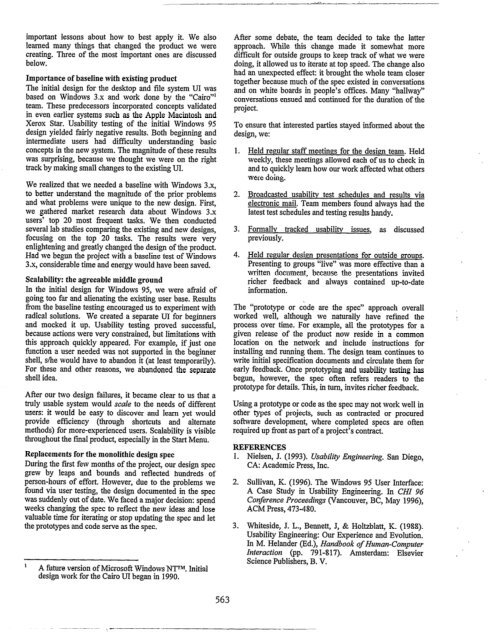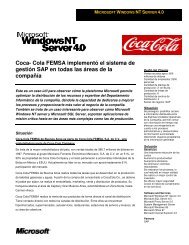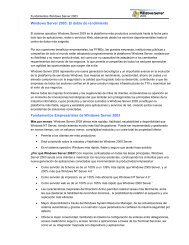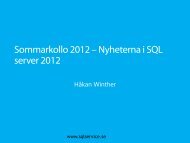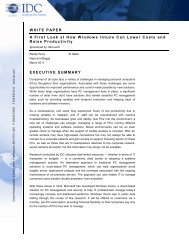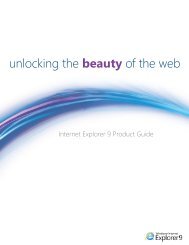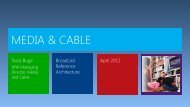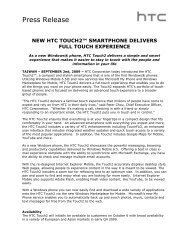The Windows@ 95 User Interface: Iterative Design and ... - Microsoft
The Windows@ 95 User Interface: Iterative Design and ... - Microsoft
The Windows@ 95 User Interface: Iterative Design and ... - Microsoft
You also want an ePaper? Increase the reach of your titles
YUMPU automatically turns print PDFs into web optimized ePapers that Google loves.
important lessons about how to best apply it. We alsolearned many things that changed the product we werecreating. Three of the most important ones are discussedbelow.Importance of baseline with existing product<strong>The</strong> initial design for the desktop <strong>and</strong> file system UI wasbased on Windows 3.x <strong>and</strong> work done by the “Cairo”*team. <strong>The</strong>se predecessors incorporated concepts validatedin even earlier systems such as the Apple Macintosh <strong>and</strong>Xerox Star. Usability testing of the initial Windows <strong>95</strong>design yielded fairly negative results. Both beginning <strong>and</strong>intermediate users had difficulty underst<strong>and</strong>ing basicconcepts in the new system. <strong>The</strong> magnitude of these resultswas surprising, because we thought we were on the righttrack by making small changes to the existing UJ.We realized that we needed a baseline with Windows 3.x,to better underst<strong>and</strong> the magnitude of the prior problems<strong>and</strong> what problems were unique to the new design. First,we gathered market research data about Windows 3.xusers’ top 20 most frequent tasks. We then conductedseveral lab studies comparing the existing <strong>and</strong> new designs,focusing on the top 20 tasks. <strong>The</strong> results were veryenlightening <strong>and</strong> greatly changed the design of the product.Had we begun the project with a baseline test of Windows3.x, considerable time <strong>and</strong> energy would have been saved.Scalability: the agreeable middle groundIn the initial design for Windows <strong>95</strong>, we were afraid ofgoing too far <strong>and</strong> alienating the existing user base. Resultsfrom the baseline testing encouraged us to experiment withradical solutions. We created a separate UJ for beginners<strong>and</strong> mocked it up. Usability testing proved successful,because actions were very constrained, but limitations withthis approach quickly appeared. For example, if just onefunction a user needed was not supported in the beginnershell, s/he would have to ab<strong>and</strong>on it (at least temporarily).For these <strong>and</strong> other reasons, we ab<strong>and</strong>oned the separateshell idea.After our two design failures, it became clear to us that atruly usable system would scale to the needs of differentusers: it would be easy to discover <strong>and</strong> learn yet wouldprovide efficiency (through shortcuts <strong>and</strong> alternatemethods) for more-experienced users. Scalability is visiblethroughout the final product, especially in the Start Menu.Replacements for the monolithic design specDuring the first few months of the project, our design specgrew by leaps <strong>and</strong> bounds <strong>and</strong> reflected hundreds ofperson-hours of effort. However, due to the problems wefound via user testing, the design documented in the specwas suddenly out of date. We faced a major decision: spendweeks changing the spec to reflect the new ideas <strong>and</strong> losevaluable time for iterating or stop updating the spec <strong>and</strong> letthe prototypes <strong>and</strong> code serve as the spec.1A future version of <strong>Microsoft</strong> Windows N?TM. Initialdesign work for the Cairo UI began in 1990.After some debate, the team decided to take the latterapproach. While this change made it somewhat moredifficult for outside groups to keep track of what we weredoing, it allowed us to iterate at top speed. <strong>The</strong> change alsohad an unexpected effect: it brought the whole team closertogether because much of the spec existed in conversations<strong>and</strong> on white boards in people’s offices. Many “hallway”conversations ensued <strong>and</strong> continued for the duration of theproject.To ensure that interested parties stayed informed about thedesign, we:1.2.3.4.Held regular staff meetings for the design team. Heldweekly, these meetings allowed each of us to check in<strong>and</strong> to quickly learn how our work affected what otherswere doing.Broadcasted usability test schedules <strong>and</strong> results viaelectronic mail. Team members found always had thelatest test schedules <strong>and</strong> testing results h<strong>and</strong>y.Formally tracked usabilitv issues, as discussedpreviously.Held regular design presentations for outside groups.Presenting to groups “live” was more effective than awritten document, because the presentations invitedricher feedback <strong>and</strong> always contained up-to-dateinformation.<strong>The</strong> “prototype or code are the spec” approach overallworked well, although we naturally have refined theprocess over time. For example, all the prototypes for agiven release of the product now reside in a commonlocation on the network <strong>and</strong> include instructions forinstalling <strong>and</strong> running them. <strong>The</strong> design team continues towrite initial specification documents <strong>and</strong> circulate them forearly feedback. Once prototyping <strong>and</strong> usability testing hasbegun, however, the spec often refers readers to theprototype for details. This, in turn, invites richer feedback.Using a prototype or code as the spec may not work well inother types of projects, such as contracted or procuredsoftware development, where completed specs are oftenrequired up front as part of a project’s contract.REFERENCES1. Nielsen, J. (1993). Usability Engineering. San Diego,CA: Academic Press, Inc.2. Sullivan, K. (1996). <strong>The</strong> Windows <strong>95</strong> <strong>User</strong> <strong>Interface</strong>:A Case Study in Usability Engineering. In CHI 96Conference Proceedings (Vancouver, BC, May 1996),ACM Press, 473-480.3. Whiteside, J. L., Bennett, J, & Holtzblatt, K. (1988).Usability Engineering: Our Experience <strong>and</strong> Evolution.In M. Hel<strong>and</strong>er (Ed.), H<strong>and</strong>book of Human-ComputerInteraction (pp. 791-817). Amsterdam: ElsevierScience Publishers, B. V.563


